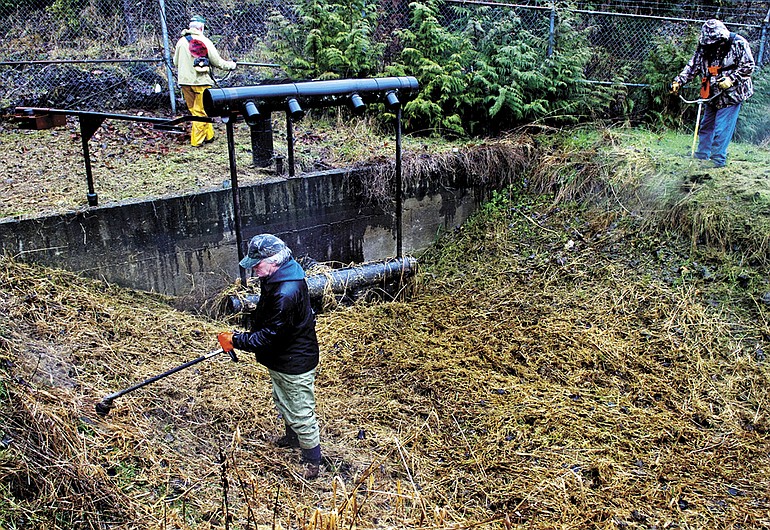TOUTLE — A dozen volunteers fired up weed wackers and cleared grass by the South Fork of the Toutle River last week, preparing ponds that will hold summer steelhead in a few weeks.
It’s a labor of love for members of the Cowlitz Game & Anglers Club, whose work helps provide a popular fishery.
Club members were grumbling while they worked, however. The 15,000 summer steelhead smolts the ponds will nurture this year is only half as many as the stocking level of the late 1990s.
Game & Anglers volunteer efforts have helped the South Fork recover from a devastating mudflow caused by the 1980 eruption of Mount St. Helens. The following year, the Corps of Engineers built the ponds along the river, about five miles east of the town of Toutle. A few years later, the Game & Anglers took over the facility.
Among their challenges is maintaining the 5,700-foot-long water supply pipe, part of which washed away during high water one year.
“Last year, we lost about half of our fish to otters,” said club President Dick Miller. Club members are fighting back — they’ve hired a trapper to rid the facility of the hungry intruders.
The Department of Fish and Wildlife supplies the summer steelhead smolts, which spend several months in the ponds to acclimate to the watershed before they’re released.
“I’ve never had trouble getting volunteers to come up and feed the fish,” said Game & Anglers member Mike Tyrrell.
With the volunteer labor, “this has got to be the cheapest pond system the department’s got,” he said.
When the smolts return as adult fish, anglers are waiting.
Even on a cold, rainy weekday this week, several fishermen were catching steelhead in the river near the work party.
“In June and July, you have fishermen wall-to-wall” on the South Fork, Tyrrell said.
“We get guys from Tacoma and Seattle fishing here all the time,” Miller said. “We’ve got a great recreational fishery thanks to what we’ve been doing.”
That’s why he and other club members question WDFW’s cutback in smolts. In the late 1990s, the agency provided more than 30,000 fish per year, which dropped to around 25,000 fish for several years. Two years ago, the agency slashed the stocking level by 40 percent.
The reduction was part of a raft of hatchery management changes in the WDFW’s Conservation and Sustainable Fisheries Plan, which also resulted in fewer steelhead smolts planted in the Coweeman River and closure of the Elochoman Hatchery in Wahkiakum County.
The reduced stocking of hatchery fish is part of WDFW’s efforts to help recovery of wild fish listed under the Endangered Species Act. Among the 13 local ESA-listed stocks are steelhead in the Columbia River basin from the Cowlitz to the Wind rivers.
Fish managers want to lessen interaction between wild and hatchery fish.
On the South Fork, not all the stocked summer steelhead are caught, and some will spawn in the river and produce offspring that will compete for space and food with the river’s wild winter steelhead juveniles. The South Fork return of wild winter steelhead has averaged 415 annually in recent years, less than half the goal. The river also supports wild coho and fall chinook.
“Wild fish or natural origin fish definitely have survival advantages over hatchery fish when they spawn,” said Bryce Glaser, a WDFW fish biologist.
Under the state’s definition, a wild fish has a genetic legacy from its river. A natural origin fish is one that was naturally produced, even if its parents came from a hatchery.
Tyrrell counters that “there isn’t any such thing as a wild fish anymore. They’ve been interbred so many years.”
Miller pointed out that WDFW policy for the river seems to change every few years.
Indeed, the agency has not followed through on previous plans for the South Fork Toutle. In 1997, the WDFW released a 400-page document called the Lower Columbia Steelhead Conservation Initiative. It called for creating a wild fish sanctuary on the South Fork, which would have meant ending all hatchery fish plants, though that never happened.
Thirteen years later, WDFW is working on a new plan for steelhead management in the Toutle, Coweeman and Kalama basin, with an advisory board that includes Game & Anglers members.
The new planning effort, which will likely be completed this year, will include recommendations for South Fork steelhead plants in the long run, Glaser said.
One idea that’s been floated is using a weir to keep hatchery fish in the lower river; wild fish would be passed upstream.
Game and Anglers members aren’t waiting for the current plan to be done; they’re already calling for bumping their pond’s steelhead quota back up to 20,000 per year.
They want anglers to lobby for the fish by documenting how many they catch on the South Fork. According to the WDFW, the reported catch ranged from 138 to 1,243 fish per year in the decade ending in 2003, though more recent figures aren’t available.
“According to most accounts, it appears we’re having more people fishing the South Fork” since then, Glaser said.
Rick Bartlett, who was working at the ponds this week, thinks the catch is higher than reported, but say anglers don’t record their catch and turn in the information to the agency.
“We need to get these guys to punch their cards,” he said.



